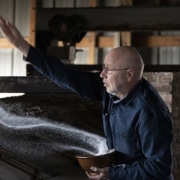ST JOHN’S UNIVERSITY | Experience Benedictine Hospitality
During your visit to Saint John’s University, tour Saint John’s Pottery and have afternoon tea at the IRORI Japanese hearth and table. Time your tour to see the Rice Blessing & Lighting Ceremony of the Johanna Kiln, the largest wood-burning kiln of its kind in North America!
Designed by Richard Bresnahan and constructed with the help of apprentices and volunteers, the Johanna Kiln can fire up to 12,000 works of pottery and sculpture. It is named in honor of S. Johanna Becker, OSB and is the largest wood-burning kiln of its kind in North America. The kiln takes at least six weeks to load and is typically fired in the fall.
Once the kiln doors are closed, the lighting ceremony begins. Hundreds of individuals from the Saint John’s community–monks, laypersons, and guests–gather to take part in the lighting ceremony. After a short prayer, the kiln area is ritually purified in the Japanese tradition with rice, salt, and sake. The Johanna Kiln is then lit with a handmade torch.
For ten consecutive days, sixty volunteers gather to stoke pieces of wood in several firing shifts that stretch around the clock. Upon completion of the firing, the kiln is sealed with recycled clay to slowly cool for two weeks. Finally, when the kiln is opened, the ceramics are carefully unloaded, cleaned, and prepared for everyday use.
THE IRORI TABLE
Visitors are welcome Monday through Friday 1:15–4:30 p.m. and Saturday 10 a.m.–4:30 p.m. Staff are often available to give tours without advance notice, though it is recommended to schedule a tour in advance via email or by calling (320) 363-2930, especially for groups. The Saint John’s Pottery is located below Saint Joseph Hall, south of the Saint John’s Art Center.
In addition to tours and purchases, guests are welcome to 3 p.m. afternoon tea at the irori table. An irori is a traditional Japanese hearth and table used for heating tea water and food as well as for generating warmth in the home. The table at the studio is most often used for tea, and on occasion it is used to prepare a meal over the central burner.
Welcoming guests into the studio as part of a rural and traditional Japanese framework for a lived system has strong parallels to the practice of Benedictine hospitality. As Saint Benedict states, “All guests who present themselves are to be welcomed as Christ, for he himself would say: I was a stranger and you welcomed me.”
Water for tea is heated in an antique cast iron kettle hung from the ceiling using a traditional jizaikagi pot hook. The water is then carefully poured over tea leaves into a wood-fired ceramic teapot. Except for tea ceremonies and other seasonal or special occasions, the tea served in the studio is a worker’s grade organic sencha green tea from the mountains of Japan.
Tea is served in a chawan tea bowl. Shallow bowls, which allow the tea to cool rapidly, are used in summer; deep bowls are used in winter. Other tea implements include the mizusashi water jar, chaire tea caddy, and kansui rinse water container. Special meals prepared around the irori table include nabe-style Japanese kettle soups, stir-frys, and noodle dishes.



